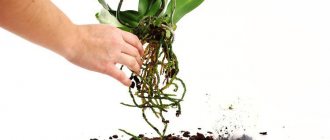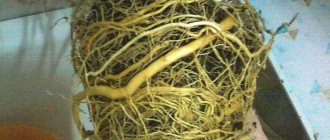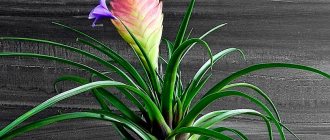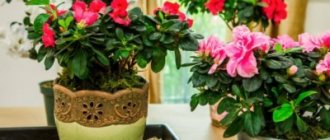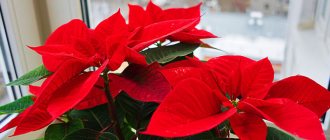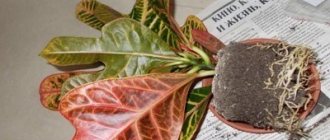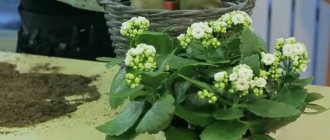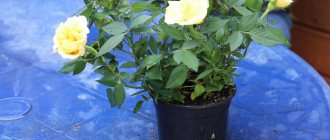Today everyone is trying to decorate their home with ornamental plants. They not only please the eye, but also have a positive effect on the well-being and mood of others. Specialized stores will offer a huge number of indoor plants to choose from, both common and exotic. Dracaena, which is also called the Dragon tree or home palm, looks great in an apartment. We will talk below about how to care for dracaena after purchase, the features of transplantation and disease control.
Dracaena
Dracaenas are popular plants due to their ease of growing and wonderful leaves that will add greenery and beauty to any corner of your home or office. The amazing tropical and graceful appearance of the plant is liked by many. I will tell you how to care for dracaena at home in this article. Dracaena can be classified as an unpretentious indoor plant that even beginning gardeners can grow. And yet, caring for dracaena is determined by some features that will help grow healthy, beautiful flowers.
Interesting! The name dracaena comes from the Greek drakaina "dragon" tree Draco Dracaena. This plant was considered by the local population to be a pro-dune dragon, the Guanches attribute magical properties to it, as it has many healing abilities. This belief was due to the fact that the juice that thickens the air turns red (dragon's blood).
General information about the plant
Dracaenas are known to many indoor plant lovers. In apartment conditions, plants are grown for their magnificent leaves. The genus Dracaena consists of one hundred and fifty species of trees, succulent shrubs and evergreen shrubs. It is worth noting that previously dracaena, like yucca and cordyline, belonged to the agave family. Subsequently, a separate family was identified, which was called Dracaenaceae, but all Dracaenae were included as a genus in the Asparagus family.
The plant is native to the Canary Islands, Guinea, tropical Africa, the island of Madagascar, South Asia, West Africa and Guinea. The height of dracaenas in nature reaches six meters, but in apartments plants grow up to three meters. One of the brightest representatives of the genus grows on the Canary Islands in Ethiopia and Somalia and produces red resin. Thanks to this phenomenon, this dracaena is called the Dragon tree “Dracena draco”. The name of the genus comes from the word “dracaina” (ancient Greek) and translated means “female dragon”.
The largest number of dracaena species grows in Africa, in South Asia there are only a few species, and in the tropical region of Central America there is one species.
Dracaena leaves are hard, leathery and linear, collected in bunches located on the smooth trunk of the plant, mainly at the top, but dracaena can also produce a bud at the bottom of the trunk and in the middle. The leaves are both narrow and long, collected in spreading rosettes, and curved and arched, up to ten centimeters wide and up to seventy centimeters long.
The veins on the leaves are parallel and join at the end of the leaf. For some time now, plants have become not only ornamental, but also industrial crops. The fibrous leaves, having the properties of horsehair and bristles, became suitable for the production of brushes.
Dracaenas are also grown as a fancy and unusual standard tree. In this case, the plant resembles a small palm tree. Therefore, the flower is often called “false palm”. Used as a central plant in a composition or as a single plant. They are valued for the beauty of their green, variegated, and striped leaves. During winter, the plant successfully survives a short-term drop in temperature of 1-2 degrees. In flower shops you can see parts of dracaenas with several rooted shoots at the top. Such forms can also be obtained individually, by rooting parts of the trunk.
Is Dracaena a palm tree or not?
The opinion that dracaena is a palm tree is very common among amateur gardeners. In fact, this is not so. Certain types of dracaenas really resemble a palm tree, since they have characteristic “scales” remaining on the tree-like trunk after shedding the lower leaves, as well as a lush top.
The Dracaena family (formerly referred to as the Agave family) is represented by large tree-like specimens, as well as smaller shrubby forms. Dracaena in the form of a tree can be found in arid and even desert areas of Africa. Shrub forms love a more humid climate and they settle in the tropical forests of Central America and Asia. It was the shrubby forms of dracaena that turned out to be most suitable for cultivation and took root well in our homes.
How to care for dracaeno after purchase
What care does dracaena require after purchase? Flower growers have different opinions on this issue. Some believe that the plant should be allowed to acclimatize to new conditions for two to three weeks and then replanted. Others believe that replanting should be done immediately after purchase, while others say that replanting is not necessary at all. To clearly understand these arguments, let’s look at all the opinions in order.
If the purchased plant has a healthy appearance, bright leaves, it is not crowded in the pot and the soil is not depleted, then replanting is not required. It is advisable to wait until spring (recommended in March-April) and transship the flower. Transplanting into a new pot after purchase is performed for the first time using the transshipment method, without disturbing the root ball.
Urgent transplantation of dracaena after purchase is required in the following cases:
- If the plant is cramped in the pot. On average, with a flower height of 45 cm, the diameter of the flower pot should be at least fifteen centimeters. If this rule is not followed, you need to transfer the plant to a larger pot 1-4 weeks after purchase (depending on the condition of the plant).
- If the soil in the pot is depleted or the plant grows in special conditions. substrate used during transportation. It is worth knowing that today many plants come to our shelves from abroad. Therefore, when purchasing, be sure to clarify where the plant came from. The plant must be replanted if there is a transport substrate.
- If the base of the soil is peat, then the flower must be replanted immediately, completely freeing the root system and replacing the substrate with a new one. The reason for urgent replanting is peat, which retains moisture; this will cause the roots of the plant to be constantly wet, which will entail the process of rotting.
When is a transplant required?
The root system of dracaena has its own characteristics. It grows quickly, completely filling the pot. In crowded conditions, dracaena develops poorly and growth stops. To create favorable conditions for life, it is necessary to regularly replant the flower.
There is no need to rush into moving a plant just brought from the store into a beautiful, spacious pot. If you do not want to do any harm, then replanting the dracaena after purchase should occur in the spring months: March and April will be the ideal time. During this period, the flower begins the active growth phase: it produces fresh foliage, increasing its growth by several centimeters.
There are cases when a dracaena plant requires an emergency transplant:
- The condition of the soil in which it was in the flower shop is of unsatisfactory quality or the pot is hopelessly small. Wait 2-3 weeks for the indoor flower to adapt to the conditions of your home. Then move it to favorable soil.
- Illness and threat of death. In this case, you also shouldn’t wait for spring. Start replanting immediately. Use special soil and fertilizers to be sure to save the flower.
Plants up to 5 years old are replanted annually. Replanting large dracaena - once every 3 years.
Caring for dracaena at home
Location and lighting
The flower does not want direct sunlight to illuminate it, but it also needs a lot of light. Dracaena domestica does not tolerate direct sunlight. Basically, indoor plants are placed in large, spacious rooms with diffused light. The light is sunny and bright, although the dracaena needs to be shaded from direct rays. Varieties with green leaves are shade-tolerant. In regions with temperate climates it can grow outdoors, but without drafts.
Temperature
Dracaena, being from a warm climate, does not tolerate cold. It grows well in hot and humid environments at temperatures around 26 ° C. When it drops to 15 ° C, the plant begins to suffer. Dracaena feels great in the interior of a winter garden with a constant temperature of 17 - 20 degrees. When keeping the plant, the temperature in the room in summer is no more than twenty-seven to twenty-eight degrees (optimal 20-23).
In the winter season, the temperature range is sixteen to eighteen degrees (not lower than twelve). In winter, the indoor plant must be installed in a room with a temperature of no more than eight to ten degrees.
Watering
Dracaena requires constantly moist soil, but not a substrate flooded with water. From April to October (the period of active growth), dracaena needs moderate watering, with water at room temperature, and the substrate should not be allowed to become waterlogged. Since the flower exists in nature in a humid environment, it needs daily spraying. In winter, watering is performed occasionally once or twice, over a period of three to four months. In winter, the substrate in the pot should be slightly damp.
Top dressing
During the spring-summer period, dracaena should be fertilized every week with liquid fertilizer along with irrigation water in small quantities (1/3 of what is specified in the fertilizer). In the autumn-winter period, feeding is suspended. Fertilizer feeding is carried out only in the summer, once every two to three weeks.
When it comes to choosing fertilizers, a good rule of thumb is to read the label that lists the ingredients. For dracaenas to grow quickly, it is preferable to use fertilizers that have a sufficiently high level of nitrogen (N) and potassium (K), which mainly contribute to the development of this plant. Also, check that in addition to macronutrients (nitrogen (N), phosphorus (P), potassium (K)), it also contains microelements such as magnesium (Mg), iron (Fe), manganese (Mn), copper ( Cu), zinc (Zn), boron (b), molybdenum (Mo), all are important for proper care of dracaena.
Some types of dracaena do not have a dormant period; they are fed with complex fertilizer once every seven days in the summer, and once a month in the winter.
Trimming
In general, dracaenas are not pruned. The basal leaves are dried slowly to prevent the occurrence of parasitic diseases; they are cut off. Be careful to ensure that the tools used for pruning are clean and disinfected (preferably flame) to avoid tissue contamination.
Soil, replanting
It is advisable to replant young plants annually. An adult dracaena is usually replanted every two to three years, in the spring, but if you follow the rules for caring for dracaena at home, it may be necessary to replant every year, as the plant grows quickly. In addition, the plant requires a lot of space for its roots. When transplanting, the container is taken 3-4 cm larger than the previous one. Be sure to use high-quality drainage.
The soil for dracaenas plays one of the main roles in development. The soil must be nutritious and slightly acidic. If it is not possible to prepare the soil yourself, then it is recommended to buy the soil mixture at a flower shop. Soil is well suited for decorative deciduous plants, which it is advisable to mix with perlite to make it loose. When preparing the soil on their own, take: leaf soil, humus, sand, peat and turf soil in equal proportions.
Prepare a soil mixture with the following composition:
- sand (1 tsp);
- deciduous soil (2 hours);
- turf soil (4 hours).
To reduce the root system by 10 kg. It is advisable to add two or three handfuls of charcoal and half a kilo of broken brick to the resulting substrate, which loosens the soil and absorbs excess moisture.
Humidity
Flowers need high air humidity. If the air in the room is dry, you should spray the dracaena with water daily, morning and evening.
See also: Why is dracaena believed to bring happiness?
Bloom
Many dracaenas have the ability to flower. The color of the flowers is white, light green, pink. Plants usually bloom once every eight to ten years. The flowers are collected in inflorescences and open only at night. The smell of flowers is pleasant. For example, fragrant dracaena blooms with miniature white-cream flowers in the summer. Dracaenas rarely bloom when grown at home in pots. Some gardeners, in the hope of flowering, place a pot with a flower in the open air so that it blooms.
Know! It is recommended to wipe the leaves of plants with a damp cloth. Do not use leaf polishes. These products clog the stomata of plants, disrupting their normal physiological functions.
Air humidity
For all dracaenas, without exception, the air humidity in the rooms where they are grown should be increased. It is necessary to spray regularly. In summer, spraying is carried out a couple of times a week. During the winter season, a pot with a plant should not be placed near central heating radiators.
The soil
The substrate for growing dracaenas must be slightly acidic. The mixture usually consists of garden soil, peat and sand (3:1:1). Replanting is carried out every two to three years, and provided that the entire volume of the pot is filled with the root system.
Step by step - how to transplant dracaena
When planting a palm tree, all actions should be performed slowly, with caution, avoiding damage to the root system and ground parts. Before starting work, you need to make sure you have settled water and pruning shears.
Instruments must be disinfected. For this purpose, the tip is calcined or treated with an alcohol-based solution.
The work is carried out in stages and includes a number of important actions:
- The drainage layer is placed first in the flowerpot. Its height should be about three centimeters. You can use pebbles, small clay shards and expanded clay as drainage.
- The palm tree is removed from the old container.
- Above the roots (in the upper part of the flower), the soil is completely removed. It is partially left between the roots.
- The root system is carefully examined. Dry, damaged and rotten roots are removed immediately. If the underground part is too large in comparison with the upper part, then you need to trim the roots. At the same time, those that are located unsuccessfully are shortened. All sections are sprinkled with ash, due to which they dry out.
- A small amount of substrate is laid on top of the drainage, which is immediately compacted.
- A palm tree is placed in the center of the container. Its roots are straightened evenly across the flowerpot. The planting depth does not change.
- The soil is poured into the pot. The container is shaken periodically so that there are no voids left.
- The soil is carefully compacted.
- The plant is watered abundantly and the leaves are sprayed. After the soil settles, another small amount of substrate is added.
Important! In the same way, if necessary, dracaena is transplanted in winter.
Using a damp sponge, remove dirt from the dracaena and flowerpot. After a quarter of an hour, excess liquid is drained from the pan.
Transplantation using the "transshipment" method
Transshipment is the most gentle type of transplantation. It is suitable for healthy mature plants that need a little more room to grow. During transshipment, the earthen material is kept unchanged. And new soil is poured between it and the walls of the pot. As a rule, dracaena tolerates this procedure well. She doesn't have to waste energy adapting.
How to transplant correctly using the transshipment method:
- Before transshipment, do not water the dracaena for 3-4 days, then the earthen lump will be preserved.
- Prepare new soil, drainage and pot.
- Place a drainage layer and some soil on the bottom.
- Tilt the pot with dracaena or, if the size allows, turn it over to get an earthen ball with roots. You can push it through the drainage hole.
- Place a ball of earth in the center of the new pot, the top of the ball should be located only slightly below the top edge of the container.
- Gradually add soil from different sides, compacting it with your fingers and shaking the pot.
- Do not fill the pot to the top to make it convenient to water the plant, and do not leave voids in the soil.
- After finishing the transplant, water the dracaena well.
- Place it in a warm (+20–22 °C), slightly shaded place.
- Water moderately for two weeks, avoiding overwatering, and spray occasionally. Observe the condition of the plant.
If no problems arise, place the dracaena in a permanent place and care for it as usual.
Transplanting a large dracaena
At home, over time, dracaena grows into a three-meter tree. It is very difficult to transplant such a giant. It is much easier to update only the top layer (5–6 cm) of soil. Humus or other useful components must be added to the new soil for nutritional value.
It is not easy to replant a tall dracaena alone. But sometimes a transplant cannot be avoided. Then look for an assistant. It is very difficult to cope with transplanting a tall dracaena alone.
Stages of transplanting a large specimen into another pot:
- Before transplanting, do not water the dracaena for several days to make it easier to remove the earthen ball from the pot.
- Prepare the soil mixture, drainage and pot.
- Place a drainage layer and some soil at the bottom of the container.
- Using a knife or spatula, carefully run along the inside walls of the old pot to loosen any embedded roots.
- If roots have grown into the drainage holes, trim them.
- Remove the dracaena with a lump of earth from the old pot (to do this, you may have to stand on a chair, holding the plant by the trunk, and an assistant will pull the pot together). Another option: carefully place the plant on its side and tap the pot well, then carefully pull out the dracaena along with the earthen lump.
- Lightly shake off the soil, do not remove all of it. Remove too long roots from below, do not worry too much during the operation - the dracaena will quickly restore what was lost.
- Transfer the plant to a new pot, place it in the center and gradually fill the distance between the walls and the earthen ball with soil, lightly compacting it.
- Water the soil around the circumference, wait for it to settle, and add more soil. But do not try to fill the pot to the brim, otherwise it will be inconvenient to water and change the top layer of soil later.
For dracaenas that are too large to avoid replanting often, you can take the pot to grow slightly. And it’s better to spend money on ceramic. It is more stable compared to plastic.
Replanting after purchase
A flower bought in a store always needs to be replanted, but there is no need to rush into it. If the plant feels good, does not turn yellow and does not show signs of disease, it is better to wait until spring. In any case, it is necessary to give the dracaena at least 2-3 weeks to adapt to the new conditions, and only after that proceed with replanting, otherwise the plant, weakened by the move, may not tolerate additional stress.
If there is no doubt about the health of the plant, wait to replant until spring. If there are any problems, such as poor soil quality, replant your false palm at any time of the year.
Reproduction
Reproduction of dracaena depends on the shape of the plant. Variegated species are propagated by air layering from the apical part of the plant or by non-lignified cuttings. Dracaena, which has green leaves, can be propagated by seeds. For rooting, use a mixture of sand and leaf soil or sand. Proper rooting should be accompanied by spraying, regular watering and maintaining a temperature of 22-26°C.
Dracaenas, which have green leaves, reproduce by seeds. Shoots appear in thirty to thirty-five days. We perform rooting by cuttings when the dracaena stretches upward. In this case, we cut the trunk into pieces, provided that each cutting has a bud ready to start growing, and we root it. For rooting we use a mixture of sand and peat and a temperature of twenty-three to twenty-four degrees.
Variegated forms of plants can be propagated from parts of non-lignified stems. To do this, make a cut on the trunk just below the leaves up to half the trunk from bottom to top. We insert a piece of a small stick into the cut so that the parts of the stem cannot connect. We wrap this place with damp moss and tie it with twine to form roots.
The best option would still be to cut the pot into two halves, or you can wrap the cut with thick paper in the shape of a funnel. We fill the pot or funnel with loose and nutritious substrate, where young roots are formed in a short time. The soil in the pot (funnel) must be constantly moist.
Then, after the roots have formed, the upper part is completely separated, and the lower stem, if desired, can be used for cuttings.
Homemade dracaena flowers can be grown using hydroponics.
Pests and diseases
Pests of the plant are red spider mites and scale insects. The plant may also suffer from thrips and mealybugs. Dracaena leaves can be damaged by spotting, which is the result of excess moisture in the soil or very dry air.
Red dots on the undersides of leaves indicate the presence of mealybugs. Pests have a protective shield, dark in color. Solution: Remove mealybugs using a cotton ball soaked in alcohol, if the plant is large, you can wash it with soap and water, very carefully wiping with a sponge to remove the parasites.
The plant should then be washed well to remove the soap. Large plants and plants planted outside the living area can be treated with special chemicals. Procedures using insecticides are more effective because they are directed against larvae, which are more sensitive than adults.
Leaves with necrotic spots with a yellow outline are a fungal attack. This usually occurs in combination with warm weather and too wet soil.
Watering and temperature conditions.
Dracaena often suffers from stagnation of excess moisture in the soil, which can lead to the death of the plant. At the same time, it requires regular, abundant watering, which decreases with the arrival of autumn. The soil must have time to dry out between waterings. This is extremely important so that the roots of the plant do not begin to rot. Particular attention should be paid to the drainage system, which will prevent water from stagnating at the roots.
Never replant a dracaena into a pot that is larger than the size it needs. This will inevitably lead to acidification of the soil.
The regularity of watering is indicated by the drying of the upper part of the soil. In the cold season, the plant requires less frequent watering, but this largely depends on the air temperature in the room. A sure way to understand that it is time to water the plant is to loosen the soil by about 5 cm. If the soil is dry, you can water it without fear.
Drying out is no less dangerous for dracaena, after which the complete death of the plant can also occur. Some gardeners use a moisture meter for indoor plants to avoid such problems.
Dracaena does not like high temperatures during the cold season, which means it may suffer from dry air. With the central heating turned on, it is necessary to humidify the air in the room and regularly spray the plant.
In order to additionally moisten the soil, you can place the pot with dracaena in a tray with water and pebbles or moss (sphagnum).
Dracaena species
There are many different types, but in indoor conditions only a few types are most widespread: D. fragrant, D. bordered and D. recurved. Although flower growers prefer to grow a wide variety of species, both variegated and striped and green.
Not demanding on lighting D. Deremenskaya, fragrant and edged. The same species plus D. bent require high air humidity. Dry air is tolerated by Dracaena canarian and Godseff.
Homemade dracaenas differ from each other in leaf color and variety of shapes. Conventionally, we can divide all types of dracaena into 2 groups, which will be based on the growth habits of flowers:
- The first group includes plants with strong trunks and comprehensive, hard leaves. Such dracaenas grow in semi-desert arid areas. A striking representative of the group is the Dragon Tree.
- The second group is shrub varieties with slender stems and flexible, belt-shaped leaves. They grow in the undergrowth of tropical forests. Known to many as shrubby dracaenas.
Dracaena deremensis comes from the tropics of Asia and Africa. Dracaena deremensis is native to Derema in East Africa, a plant that never grows to significant size. It grows very slowly, growing up to one and a half, maximum up to 1.5 m. The plant has the shape of leaves:
- conical;
- broadly ovoid;
- belt-shaped;
- spear-shaped.
Leaves can also be long, narrow, short, or wide. The color is green, with white, yellow stripes or fields located longitudinally. There is a variety with solid green leaves that is not as popular as the variegated varieties.
Dracaena Derema
There are many varieties: Dracaena deremensis var. Bausei with white central stripes and deremensis Dracaena var. Warneckii with two yellow stripes on the sides of the leaves and a green central stripe. Dracaena braunii is a sucker that, if placed in water, develops leaves and roots within three months. The plant does not have variegated leaves. It has very fragrant flowers, but rarely blooms at home.
Know! Typically, Durham dracaena is vertically columnar, but if desired, it can be formed into a neat little tree by pruning.
Fragrant dracaena (Dracaena Fragrans) is so named because the flowers have a sweet aroma during the flowering period. The Dracaena Fragrans have a bare and woody single stem leading to a group of leaves at the top. The leaves are bright green with a silver-gray stripe in the middle. At home, with proper care, it reaches a height of 2 meters. In winter, the plant can withstand t = 10°C. A popular variety, "Massangeana", has yellowish-green longitudinal stripes down the center of the leaf. This variety is also known as lucky bamboo.
dracaena fragrant
draco or dragon tree is native to the Canary Islands. The plant reaches outstanding sizes, has a longevity of 500 to 600 years, and has the ability to grow secondary in thickness. Some trees grow up to nine thousand years. The leaves are green and often tend to blue fleshy.
Know! D.draco reproduces only by seeds. In winter, avoid watering completely for the D.draco species. In summer it should be kept in the sun, and in winter at t=10°C in a bright place.
The trunk is thick, up to four meters at the base, branched to a height of twenty meters. Thick branches are decorated with dense bunches of leaves. The leaves are leathery, linear-xiphoid, length up to 60, width up to 4 cm. The color is gray-green, the leaves are densely arranged. When grown at home, Dracaena Canarias reaches up to 1.5 m in height.
Interesting! In the Parque del Drago (Canary Islands) there is a tree whose age is about 2.5-3 centuries.
Dracaena sanderiana is a low-growing plant with a thin stem that is densely leafy. The leaves are narrow, slightly curved, 15-20 cm long and 1-3 cm wide. The color of the leaves is greenish with wide stripes of silver-gray and white. The area of the stripes is larger than the main green tone.
Dracaena Sanderiana
Dracaena sanderiana, also known as "Brazil's dowry".
Synonyms:
- Dracaena Sandera;
- lucky bamboo;
- bamboo friendship;
- climbing bamboo;
- Chinese water bamboo;
- ribbon plant;
- Goddess of mercy.
Judging by the name of the plant, you might think that its homeland is Belgium and China, but this is not so. The plant comes from Asia. Sanderiana dracaena is native to tropical Africa (Congo). It has leaves that are striped with white and arranged in a rosette at the end of the trunk. This is a shrub plant that does not exceed one and a half meters in height. It is mistakenly believed that Dracaena Sandera is bamboo.
The plant is easy to grow in water. It is advisable to protect the flower from direct sunlight and t<15°C. The flower is grown not only in water, but also in soil. Before planting in a pot, it is necessary that the plant has well-developed roots. When growing in a pot, they prefer spraying.
Dracaena Sandera
Keeping lucky bamboo in offices and living spaces is believed to bring happiness and prosperity. This sign contributed to a huge number of sales of lucky bamboo in decorative pots.
Attention! The plant has become a popular houseplant in India, where dracaena is imported from Taiwan and China.
Dracaena surculosa is the most characteristic species. The leaves are short, green in color with many yellow dots. In addition, it can reach 1.0-1.5 meters in height.
Unlike species of its genus, this is a plant that prefers shady places. Interestingly, Dracaena surculosa in translation means shoot-forming dracaena. Young shoots of the plant emerge from the soil. The young plant quickly grows shoots. The plant can bloom when grown outdoors. The flowers have a strong scent and red-orange berries.
Dracaena surculosa
Dracaena marginata or Dracaena marginata is a plant native to Madagascar. One of its features is that as it grows, the trunk lengthens and the lower leaves fall off, leaving marks that are a fun decorative element.
dracaena marginata
Another feature is due to the fact that the leaves are still developing in the basal part: this is due to the fact that in the spring the dormant buds located in the soil wake up. This happens when the plant is kept in active sun, because this way the process of photosynthesis occurs better. The flower grows up to three meters. The leaves are narrowly lanceolate, glossy, up to 50 cm long and up to 2 cm wide. The main color of the leaves is green, but there are varieties with red and yellow stripes. Main varieties:
- Dracaena marginata tricolor - narrow red and yellow stripes.
- Dracaena marginata colorama - wide red border.
- Wild Dracaena marginata has green leaves and a reddish-purple stripe along the edge.
- Variety Dracaena bordered var. Tricolor has leaves with creamy white grooves.
- Colorama - wide red stripes along each side of the leaf.
- THhcolor – stripes green, cream and red.
The plant is unpretentious and requires minimal attention. It is not demanding on lighting, but a dark corner is not suitable for it either. The best option is diffused light, that is, the side opposite the window.
Dracaena reflexa is grown mainly in greenhouses with high humidity and temperature parameters, as well as in heated winter gardens. It is not suitable for growing indoors, as it is the most capricious. The leaves are dense, lanceolate, slightly curled, tapering at the base. Leaf color is green. The most popular variety is “Song of India”, which has variegated leaves with two light yellow stripes along the edges.
Dracaena_reflexa
Dracaena Reflexa_Song of India
Draceana goldieana - has a short and thin trunk. The plant responds well to care at high humidity and temperatures of at least 20 degrees. The leaves are creamy white with dark green stripes. The length of the leaves is 20 cm, the width in the middle part is 12 cm, the leaves taper towards the top.
Draceana goldieana
Dracaena godseffiana is suitable for keeping in a winter garden, a spacious living room, a small room, a hotel lobby, a restaurant hall. The height of the plant is from fifty centimeters to 3 m. The shape of the leaves, unusual for dracaenas, is oval, arranged whorled (3-5 pieces). The length of the leaf blades is seven to ten, width 3-5 cm. The leaves are leathery with a green-glossy surface, which is decorated with spots: cream, light green, white.
Dracaena godseffiana
What kind of lighting does dracaena need?
Like all specimens that came to us from tropical and subtropical regions, dracaena loves moisture and warmth. By the color of the leaf plate, you can easily determine how shade-tolerant a given species is. For example, Dracaena fragrans
and
Dracaena marginata (Dracaena marginata, also known as Dracaena reflexa)
, are the most
shade-tolerant
.
Variegated forms, such as Dracaena deremensis
and
Dracaena godseffiana, are more demanding on lighting
. Do not confuse shade-tolerant plants with shade-loving ones. Dracaena does not belong to the latter, although it can tolerate insufficient light for some time.
The most correct thing would be to place the pot with dracaena so that it does not receive direct sunlight, and there is no need to hide the plant in the shade. Diffused sunlight or partial shade is ideal. In winter, additional lighting (phytolight) will not be superfluous. As a rule, plants that do not go dormant for the winter need about four hours of additional light per day. Fluorescent, sodium, energy-saving, LED phytolamps are suitable for these purposes.
Artificial lighting cannot replace sunlight for a plant, but it will help create growing conditions that are as close as possible to its natural habitat. Plants with additional lighting grow faster and look healthier.
Caring for dracaena in winter
Everyone knows that winter is the hardest time for indoor plants. In winter, most indoor plants suffer from dry air in the house and high temperatures. The dracaena plant is one of them. Since the plant comes from a humid climate, dry air has a bad effect on dracaena, not giving it good conditions during the dormant period.
Attention! D. godseffiana and D. sanderiana winter minimum t=10°С.
To help the plant, you need to periodically spray the flower with warm, settled water. A good solution to the problem is to place the plant pot in a larger pot filled with moisture-resistant material.
As for watering in winter, water indoor flowers much less often than in summer. The volume and frequency of watering depend proportionally on the room temperature. The lower the temperature, the less often you need to water the flower. Dracaenas tend to rot the root system, so it is better not to top up the flower than to overwater it. How to determine watering time? Proper watering should be accompanied by drying of the top layer of the substrate by 4-5 cm.
An important factor in keeping dracaena in winter is temperature. On a personal note, I would like to note that my dracaena overwintered well for several years in the kitchen, where the winter temperature was 10-15°C. I watered my beauty once every 1.0-1.5 months. This year, after repairs and installation of a new window, the temperature in the kitchen has become much higher and the plant is suffering, as a result the leaves turn yellow and droop.
Know! Many flower lovers often confuse dracaena with cordyline, which are very similar in appearance. Unfortunately, they are difficult to recognize visually, since the main difference between plants is determined only by the root system. Dracaena's roots are orange, while Cordyline's are white.
Transfer
Although you can replant dracaena regardless of the time of year, it is better to do this work in the spring .
Young plants (up to 4 years old) need this procedure annually. Later, once every 2-3 years they do transshipment; annually they only update the top layer of the soil mixture. Although dracaena is not picky about the composition of the soil, store-bought composition for palm trees is considered the best. If you can’t buy it, you can make your own soil mixture from well-ripened compost, leaf humus, peat, and sand. It is recommended to add some coal. It is important that the result is a soil that allows water and air to pass through well.
Expert opinion
Vera Ivanovna Sh
Since childhood, I have been interested in growing indoor flowers, then I decided to devote my life to landscape design and gardening.
The pot is selected so that the diameter is 5-6 cm larger than that of the old container. The clay one is scalded with boiling water and soaked in water for several minutes. It is advisable to place a clay shard at the bottom, then add drainage (coarse sand).
The plant with straightened roots is placed in the center, the soil mixture is poured and slightly pressed down. The dracaena is sprayed, watered and placed in a permanent place. The plant may look sick for some time after transplantation. More often this happens if part of the roots are cut out during replanting.
Dracaena leaves dry out and turn yellow
- The leaves are fading - this symptom is associated with many factors, this indicates that the owner of the plant does not know how to properly care for dracaena at home. Excess water, humidity or low temperatures can cause foliage to wilt. Remedy: It is necessary to determine the condition of the soil. If the soil is too dry, adequate watering must be provided; if too wet, stop watering the flower until the soil dries out, and then resume watering sparingly. If both situations are excluded, then you need to move the plant to a warm place.
- The leaves (tips) dry out and spots form – excess fluoride.
- Withered leaves turn yellow - moisture stagnation in the pot; dry air.
Interesting! Dracaena was known in ancient Rome, where its juice was used as a dye, and then for its medicinal properties in the Middle Ages in alchemy.
Watering rules
When providing your dracaena with proper care at home, remember: in spring and summer, water the flower every other day, having first checked the soil moisture at a depth of 2 cm. There should be enough water so that it spills onto the tray, but excess should not be left in it, so as not to rot the roots. In winter, dracaena is watered once every 2 weeks, if it is not located close to a heating device.
Tap water must be passed through a filter to remove chlorine. Another option: pour it into some container and add coal.
